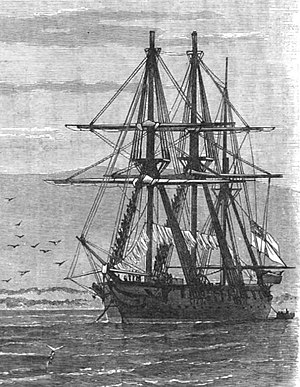HMS Niger (1846)

HMS Niger at Vera Crux (Illustrated London News)
|
|
| History | |
|---|---|
|
|
|
| Name: | HMS Niger |
| Ordered: | 20 February 1845 |
| Builder: | Woolwich Dockyard |
| Laid down: | May 1845 |
| Launched: | 18 November 1846 |
| Decommissioned: | 1869 |
| Refit: | Lengthened at Deptford Dockyard in 1848 |
| Fate: | Sold to Castle in 1869 for breaking |
| General characteristics (after 1848 conversion) | |
| Class and type: | Niger-class screw sloop (later "corvette") |
| Displacement: |
|
| Length: |
|
| Beam: | 34 ft 8 in (10.57 m) |
| Draught: | 15 ft 6 in (4.72 m) |
| Depth of hold: | 21 ft 5.5 in (6.541 m) |
| Installed power: | 1002 indicated horsepower |
| Propulsion: |
|
| Sail plan: | Full-rigged ship |
| Speed: | 10.25 kn (18.98 km/h) under power |
| Complement: | 160 |
| Armament: |
|
HMS Niger was an 8-gun (later 14-gun) screw sloop launched on 18 November 1846 from Woolwich Dockyard. She had been intended as a sailing sloop but her design was lengthened to fit a steam engine, and she was fitted with screw propulsion at Deptford Dockyard in 1847-48 prior to completion. She was reclassified as a corvette in 1852.
She conducted important propulsion trials, finally proving the superiority of screw propulsion and served in West Africa, the Crimea, China, the East Indies and Australia. She took part in the New Zealand land wars in 1860 and was sold for breaking in 1869.
She participated in 1849 in trials in the English Channel with the paddle sloop HMS Basilisk. Basilisk had started life as her sister ship when both were designed as sailing sloops, but while Niger received screw propulsion, Basilisk was fitted with paddles. Although previous trials, including a similar comparison between Rattler and Alecto in 1845, had shown that screw propulsion was broadly superior, the 1849 trials pitted two near-identical ships against each other. Since both ships had the same lines and steam engines developing almost identical power, the results confirmed the superiority of screw propulsion over the paddle-wheel once and for all. After the trials she formed part of the West Africa Squadron. She served in the Baltic Sea during the Crimean War in 1854-1855. Between 1856 and December 1858 she was sent to the East Indies Station and China Station, and then sailed for the Australian Station.
On 28 March 1860, during the First Taranaki War, a party of approximately 60 marines and bluejackets under the command of Captain Peter Cracroft landed at Waireka as reinforcements in the engagement that was taking place there. After reaching the Omata stockade near dusk, they proceeded to storm the by now lightly defended Kaipopo Pā. Coxwain William Odgers broke through the palisades and pulled down the Māori ensigns flying there, and received the first Victoria Cross of the New Zealand wars as a result.
...
Wikipedia
